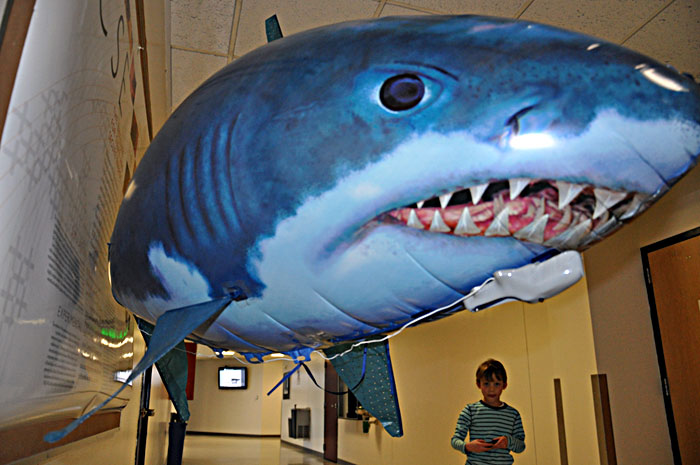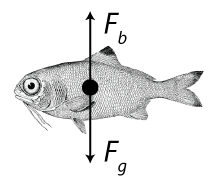
Air Swimmers
Summary
The air swimmers are remote controlled balloons, which demonstrate the concept of buoyancy. The balloons are filled with helium and float due to the difference in density between the ambient air and helium. They are propelled through the air by motorized flippers, demonstrating laws of motion and the fluid nature of gas.
General Information
Essential Questions
- What is neutral buoyancy?
- How do the laws of motion allow fish to swim?
Materials & Methods
Archimedes’ Principle
The pressure (a force per unit area) in a static fluid at any point is caused by the weight of fluid above that point being pulled down by gravity. This relationship between pressure and depth (assuming a constant density) is described by Equation 1.
|
|
P = ρf g h |
(1) |
where P is pressure, ρf is the density of the fluid, g is the gravitational acceleration (9.8 m/s2), and h is the depth of the fluid. If we integrate this pressure over the area of an object submerged or partially submerged we find:
|
|
Fb = – ρf Vf g |
(2) |
where Vf is the volume of the fluid displaced by an object within it. Of course the other force acting on any object on earth is the force of gravity:
|
|
Fg = m g = ρo Vo g |
(3) |
where m is the mass of the object, ρo is the density of the object, and Vo is its volume. If these two forces are equal then the object would be stationary, neither floating up or sinking down in the fluid. When Equations 2 and 3 are equal then we find that ρo Vo must equal ρf Vf; to put that another way the weight of fluid displaced must equal the weight of the object.

Figure 1. A neutrally buoyant object has its buoyant force balanced with its gravitational force.
Motion Through a Fluid
We can propel these air swimmers through their fluid (air), by moving their tail back and forth. As the tail moves it must push air out of its way, push it in a direction away from the direction it is intended to go. This is a simple illustration of Newton’s laws of motion. The action of pushing air in the negative direction generates the opposite reaction of propelling the air swimmer forward.
However, this motion does not continue indefinitely; as the first law of motion indicates, there must be an additional force acting on the air swimmer. An object moving through a fluid experiences a force due to its interactions with the fluid, a drag force. See our Drag/Control Module (https://www.che.utah.edu/outreach/module?p_id=10) for the theory behind basic drag. In short, the air swimmer, as it moves forward must push air out of its way and drag some of it along, transferring its kinetic energy as it goes until it once again comes to a halt, once again only experiencing gravitational and buoyant forces.
Background for Teachers
Introductory Physics
Intended Learning Outcomes
- Students will understand Archimedes principle.
- Students will understand what is meant by “neutrally buoyant”.
Instructional Procedures
- Start by explaining the archimedes principle and how that directly correlates to the module.Explain what a drag force is and how it relates to Newton’s law of motion and how it applies to the balloons going through the air. From here, fill the balloons with helium and proceed to conduct the module as mentioned above. When cleaning up the module and releasing helium, do not let anybody suck the helium from the balloon. Helium is an inert gas so it is not harmful when exposed to the air but when consumed, it makes a lack of oxygen in the brain and cause light-headedness, blurred vision, and faintness. Just open a window and let the balloons release the gas near the window.